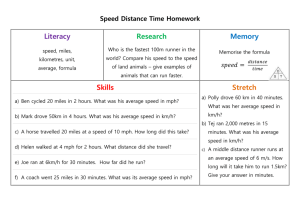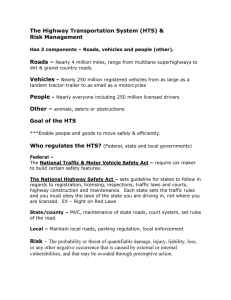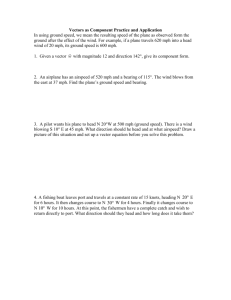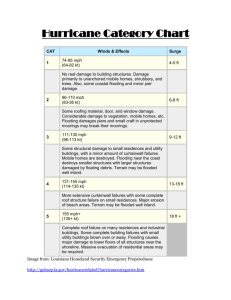Train Model – Typical Tour-of
advertisement
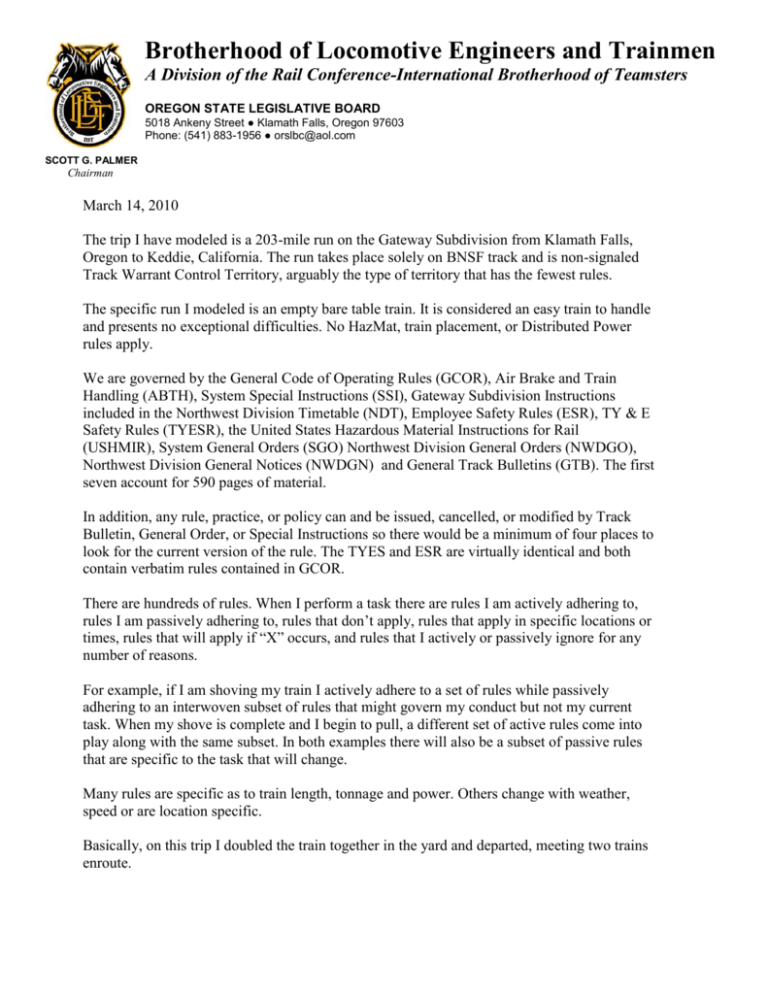
Brotherhood of Locomotive Engineers and Trainmen A Division of the Rail Conference-International Brotherhood of Teamsters OREGON STATE LEGISLATIVE BOARD 5018 Ankeny Street ● Klamath Falls, Oregon 97603 Phone: (541) 883-1956 ● orslbc@aol.com SCOTT G. PALMER Chairman March 14, 2010 The trip I have modeled is a 203-mile run on the Gateway Subdivision from Klamath Falls, Oregon to Keddie, California. The run takes place solely on BNSF track and is non-signaled Track Warrant Control Territory, arguably the type of territory that has the fewest rules. The specific run I modeled is an empty bare table train. It is considered an easy train to handle and presents no exceptional difficulties. No HazMat, train placement, or Distributed Power rules apply. We are governed by the General Code of Operating Rules (GCOR), Air Brake and Train Handling (ABTH), System Special Instructions (SSI), Gateway Subdivision Instructions included in the Northwest Division Timetable (NDT), Employee Safety Rules (ESR), TY & E Safety Rules (TYESR), the United States Hazardous Material Instructions for Rail (USHMIR), System General Orders (SGO) Northwest Division General Orders (NWDGO), Northwest Division General Notices (NWDGN) and General Track Bulletins (GTB). The first seven account for 590 pages of material. In addition, any rule, practice, or policy can and be issued, cancelled, or modified by Track Bulletin, General Order, or Special Instructions so there would be a minimum of four places to look for the current version of the rule. The TYES and ESR are virtually identical and both contain verbatim rules contained in GCOR. There are hundreds of rules. When I perform a task there are rules I am actively adhering to, rules I am passively adhering to, rules that don’t apply, rules that apply in specific locations or times, rules that will apply if “X” occurs, and rules that I actively or passively ignore for any number of reasons. For example, if I am shoving my train I actively adhere to a set of rules while passively adhering to an interwoven subset of rules that might govern my conduct but not my current task. When my shove is complete and I begin to pull, a different set of active rules come into play along with the same subset. In both examples there will also be a subset of passive rules that are specific to the task that will change. Many rules are specific as to train length, tonnage and power. Others change with weather, speed or are location specific. Basically, on this trip I doubled the train together in the yard and departed, meeting two trains enroute. Train Information: B-PTLSIF7-12A, on duty 1100, March 13, 2010 at Klamath Falls, Oregon. Call time: 1000. Destination: Keddie, California via BNSF Northwest Division Gateway Subdivision. 202,8 miles of non-signaled TWC. 0 loads, 62 empties, 2000 tons, 6,111-feet including power. Power: BNSF 5421 & BNSF 681, total horsepower-8,800. HPT-4.4, scheduled HPT-2.5, 16 axles of dynamic brake. My mandatory rules compliance started before I was on duty (GCOR 1.4, 1.5, 1.6, 1.6.1, 1.6.2, 1.6.3, 1.9, 1.16, 1.17, 1.18. TYES 1.2.11. ESR S-1.2.11, S-28.5, S-28.6, S-28.8, S-28.9, S-28.14, S-28.15, S-28.16, & S-28.17.) At 1000, I received my automated call to be at work at 1100. I arrived at the yard office at 1100 and began assembling my paperwork (GCOR 1.1, 1.1.1, 1.1.2, 1.1.3, 1.1.4, 1.3.1, 1.3.2, 1.3.3, 1.4, 1.5, 1.6, 1.7, 1.8, 1.9, 1.10, 1.11, 1.12, 1.13, 1.14, 1.15, 1.17, 1.19, 1.24, 1.27, 1.47 & 3.3. ABTH 100.10, 100.19, 100.20, 102.11, 102.14, 106.0, & 106.1. NDT item 2, 4, & 7. SSI 1, 1C, 2A, 13, 14, 17, TYES Rules amendments 31, 39, 43, & 49. ESR S-1.0, 1.1, 1.2.1, 1.2.2, 1.2.3, 1.2.4, 1.2.5, 1.2.6, 1.2.7, 1.2.8, 1.2.9, 1.3.1, 1.3.2, 1.4.7, 1.5.1, 1.5.2, 1.5.3, 5.1, 5.3.1, 5.3.2, 20.5.2, 21.1, 21.2, 21.2.2, 25.1, 25.2, 26.4, 26.6, 26.7, 28.1.1, 28.1.2, 28.1.3, 28.1.4, 28.3.1, 28.4, 28.5, 28.6, 28.6.1, 28.7, 28.8, 28.9, 28.10, 28.11, 28.12, 28.13, 28.14, 28.15, 28.16, 28.18, 28.23, 28.23.1, 28.26, 28.27 & 28.61. TYES 1.0, 1.1, 1.2.1, 1.2.2, 1.2.3, 1.2.4, 1.2.5, 1.2.6, 1.2.7, 1.2.8, 1.2.9, 1.3.1, 1.3.2, 1.4.7, 1.5.1, 1.5.2, 1.5.3, 5.1, 5.3.1, 5.3.2, 20.5.3, 21.1, 21.1.1, 21.2, 21.2.1, 21.2.2, 25.1, 25.2, 26.4, 26.6, & 26.7. SGO 29, 32, & 38. NWDGO 108. NWDGN 2, 3, 4, 5, 22, 67, 102, 188, 190, 222, & 223). All of these rules must be understood and complied with within 30 minutes under threat of discipline. At 1115 I grab my belongings and walk outside to the crew van and ride to the train. For the sake of brevity I will include the TYES rules but not the duplicate ERS rules. I will also no longer include the subset of employee conduct rules and assume I will comply with them throughout the trip. I won’t. (GCOR 1.1.1, 1.1.2, 1.6, 1.9, 1.10, 1.13, 1.20, 1.33. TYES 1.1, 1.2.10, 1.3, 1.4.9, 1.5.2, 1.5.3, 1.6.1, 12.5, 12.8 & 13.5.5. NWDGN 5, 190, 222 & 223.) 1120-board locomotive, walk through units, release handbrakes and configure for operation. (GCOR 1.1.2, 1.1.4, 1.6, 1.9, 1.10, 1.13, 1.20, 1.22, 1.23, 1.24, 1.29, 1.30, 1.40, 1.47, 2.1,.2.2, 2.5, 2.7, 2.9, 2.16, 2.17, 5.9, 5.9.1, 5.9.5, 5.10, 5.11, 5.13.1. ABTH 100.6, 100.7, 100.10C, 100.19, 101.1, 101.2, 101.7, 101.9, 101.10, 101.15, 102.2, 102.13, 102.14, 103.1 & 104.10. TYES 1.1, 1.2.3, 1.2.5, 1.4.1, 1.4.6, 1.5.3, 1.6.1, 13.1.3, 13.1.4, 13.5.2, 13.5.5, 13.6 & 25.1. SGO 32 amending ABTH 101.2. NWDGN 188, 190, 222 & 223.) 1125-cut the engines off the train in seven track, pull over the switch and back up 50 cars in six track to make a joint. (GCOR 1.1.1, 1.1.2, 1.2.9, 2.1, 2.2, 2.3, 2.4, 2.6, 2.8, 2.13, 5.2.1, 5.3.3, 5.3.6, 5.3.7, 5.8.1, 5.8.2, 5.9.1, 5.9.4, 5.9.5, 6.1, 6.22, 6.28, 6.32.2, 7.3, 7.4, 7.6, 8.2, 8.12, 8.13, 8.15, 8.17 & 8.20. ABTH 101.13, 101.14, 102.1.2, 103.0, 103.4, 103.5, 103.6.1A & 106.8. NDT item 1, 4 & 7. SSI item 1, GCOR amendments 7.1, 7.6, 8.2, 8.12, 15.2B, ABTH amendment 101.13. TYES amendment S-13.2.2. TYES 1.1, 1.2.3, 13.1, 13.1.2, 13.3.3, 13.7.1, 13.7.3, 25.1. NWDGO 108 amending NWDT items 1 & 7. NWDGN 222 [A & B], 223 [A & B] which contradicts 222 A & B). As you can see, if I continued in this vein this model would be unreadable. I will now list the actions I took during the rest of the trip without referring to the rules that were actively or passively complied with. 1128-receive track warrant to Milepost (MP) twenty. 1131-void Form A 6543. 1135-make a joint on cars in six track. 1137-pull beyond seven track switch. 1145-back onto train, pump air, test air. 1152-depart yard, yellow flag 1156-whistle for two crossings at 10 MPH counting in my head for the proper delay time. 1200-rear of train out of yard track, increase speed to twenty MPH. 1201-out of 6.28 limits, increase speed to forty MPH, test counter. 1211-first “test mile,” test speed indicator. 1217-roll up track warrant while moving and whistling for crossing. 1220-Receive new warrant to MP 31. 1226-cross first trackside detector. 1240-two miles from end of authority, slowing with dynamic brake. 1247-stopped at clear block MP 31 at automatic interlocking. 1253-set and centered. 1255-new warrant to MP 76, reverser forward, air released, delayed within a block (automatic interlocking). 1258-go over diamond, drop throttle per rule. 1348-yellow flag for 25 MPH. 1351-received new warrant to S SS Bieber. 1354-Out of 25 MPH slow order, still in 60-mile long 40 MPH slow order. 1356-Out of 40 MPH slow, increase to maximum authorized speed of 40 MPH. 1424- N SS Bieber. 1428-Rolled up North Siding Switch Bieber while moving between switches to a stop at S SS Bieber. 1430-Stopped at South Switch, headlights dimmed, air set, reverser centered. 1510-Conductor reports reversing S SS Bieber. I respond. 1521-Opposing train arrives, roll by inspection, headlights on bright, reverser forward, air released and charging. 1527-Conductor reports S SS Bieber normal. I respond. 1530-New warrant to S SS Almanor, depart. 1530-1552- heavy ascending grade at 25 MPH. 1610-sag with heavy grades both sides 25 MPH. 1630-steady heavy ascent, deep blowing snow, begin 40 MPH 1715- end 40 MPH, begin 49. 1725-performed running air brake test per the rule. 1730-heavy grade descent, dynamic braking. 1815- N SS Almanor 1817-Rolled up North switch while stopping at South switch. 1820-Stopped, headlights dimmed, set and centered. Complied with location and grade specific rules. 1831- S SS Almanor reported reversed. 1834-Train arrives, roll by inspection. 1839-S SS Almanor restored. 1845-Received warrant to CTC Keddie, our crew change point. Pulled onto descending mountain grade at 25 MPH. Some rules that normally apply don’t because of the tonnage of the train. 1910-off mountain grade, increase to 40 MPH. 1923-25 MPH slow order. 1926-passed slide fence signal. 1928-entered 20 MPH track, complied with harmonic rocking rule. 1943- passed distant signal. 1947-stopped at crew change point, headlights dimmed, air set, reverser centered. 1950-rolled up warrant. Checked voice mail. 2040-outbound crew arrives. Safety briefing, depart in crew van. 2100-tie up at Motel. It would be easier to list the rules that did not come into play. Moving the train easily adds dozens and dozens more rules, many of them amended by more than one document. Our GTB’s alone counted 16 pages of material consisting of five slow orders, two of those contained within the limits of another slow order. The rules apply differently to every train. Had we had Hazardous cars, different rules would have applied. The same holds true if our tonnage was different or if we had more locomotives. The weather changed the interplay of rules and the same train on the same territory would be governed by a different set of rules in July than it was in March. We have rules that tell us when and how to tie up on the computer, if we can go to the store to get something to eat, what to do if our room is dirty, how to walk and talk and act. They change if it snows or blows or rains. They are revised or amended almost daily by General orders and Notices. If you don’t like a particular interpretation you can shop around for managers until you find one that agrees with your interpretation. We have rules that say “you must,” rules that say “you must not,” and then all of the “you should” rules. And of course, the rule that says you must follow the rules. And they all change at a whim. Scott Palmer Klamath Falls, Oregon





